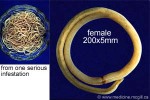Cook Islands Biodiversity Database
Species Page
Ascaris lumbricoides
Acaris
Multimedia & Additional Resources
| Type | Description | Download |
| Adult female and a serious infestation | 45KB | |
| Life cycle (McGill University) | 95KB |
General Information
Cook Islands Distribution
| Southern Group: Present Makatea: Present | ||||||||
RR |
MG |
AT |
MK |
MT |
AK |
PL |
TK |
MN |
| Northern Group: Present | |||||
TN |
MH |
RK |
PK |
NS |
SW |
Pests & Hosts
| Relationship | Hosts |
| Parasite - internal | Homo sapiens, |
Scientific Taxonomy
Ascaris lumbricoides Linnaeus, 1758
TAXONOMY: ANIMALIA; NEMATODA; SECERNENTEA (=Phasmidia); Ascaridida; ASCARIDIDAE
More Information
GENERAL NOTE: Notes for diagram of life-cycle (McGill University): Adult worms1 live in the lumen of the small intestine. A female may produce up to 240,000 eggs per day, which are passed with the feces 2. Fertile eggs embryonate and become infective after 18 days to several weeks 3, depending on the environmental conditions optimum: moist, warm, shaded soil). After infective eggs are swallowed 4, the larvae hatch 5, invade the intestinal mucosa, and are carried via the portal, then systemic circulation to the lungs 6 . The larvae mature further in the lungs (10 to 14 days), penetrate the alveolar walls, ascend the bronchial tree to the throat, and are swallowed 7. Upon reaching the small intestine, they develop into adult worms 1. Between 2 and 3 months are required from ingestion of the infective eggs to oviposition by the adult female. Adult worms can live 1 to 2 years. (CDC 1999)
Vouchers & References
Vouchers:
Pukapuka: reported by Dr Steve Kennier, 1980s, as common.
References:
None recorded.
Data Update History (information):
zTX, zB02, zM05a
Web Resources
Citation Information
McCormack, Gerald (2007) Cook Islands Biodiversity Database, Version 2007.2. Cook Islands Natural Heritage Trust, Rarotonga. Online at http://cookislands.bishopmuseum.org. ![]()
Please refer to our use policy.

